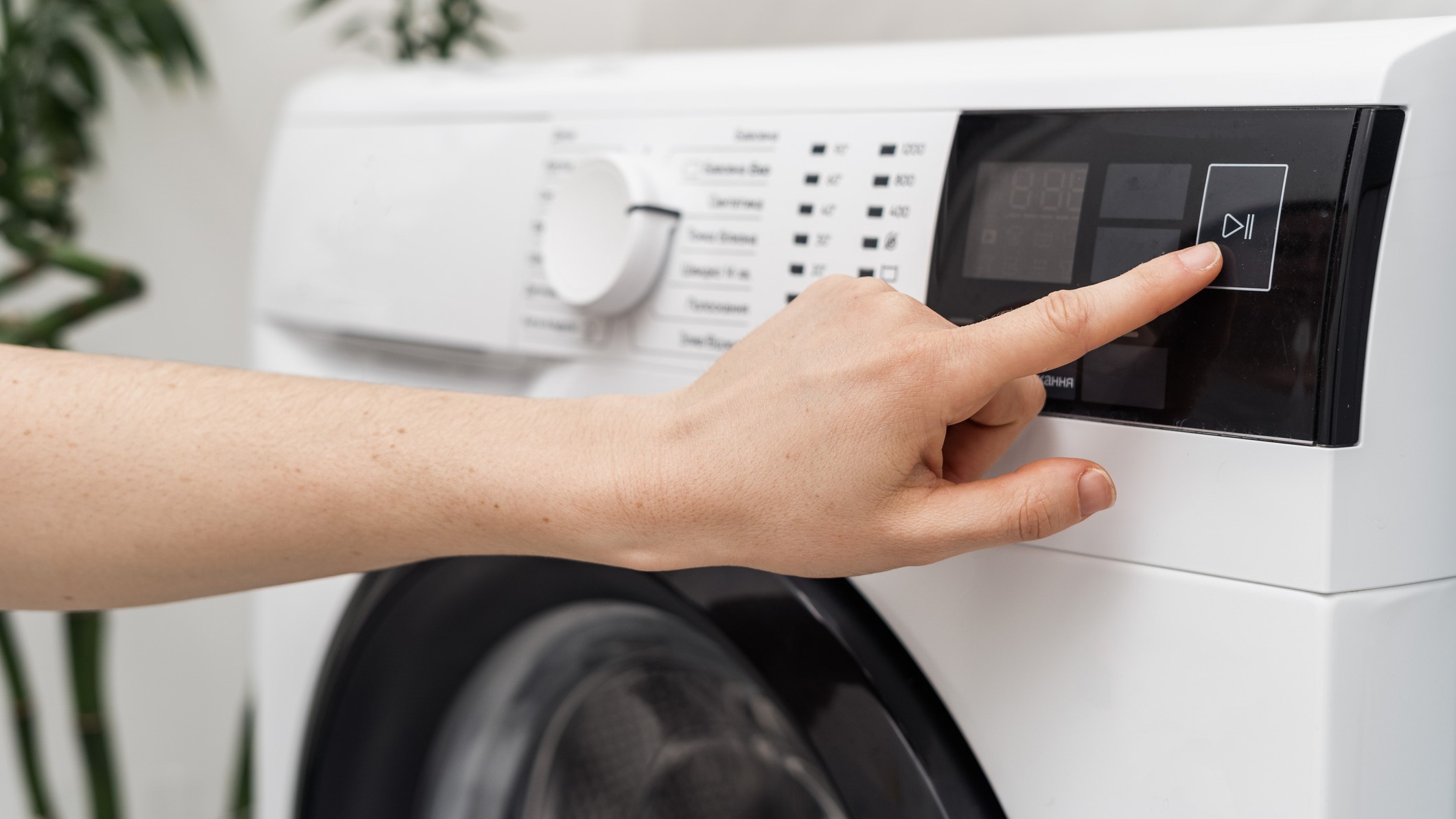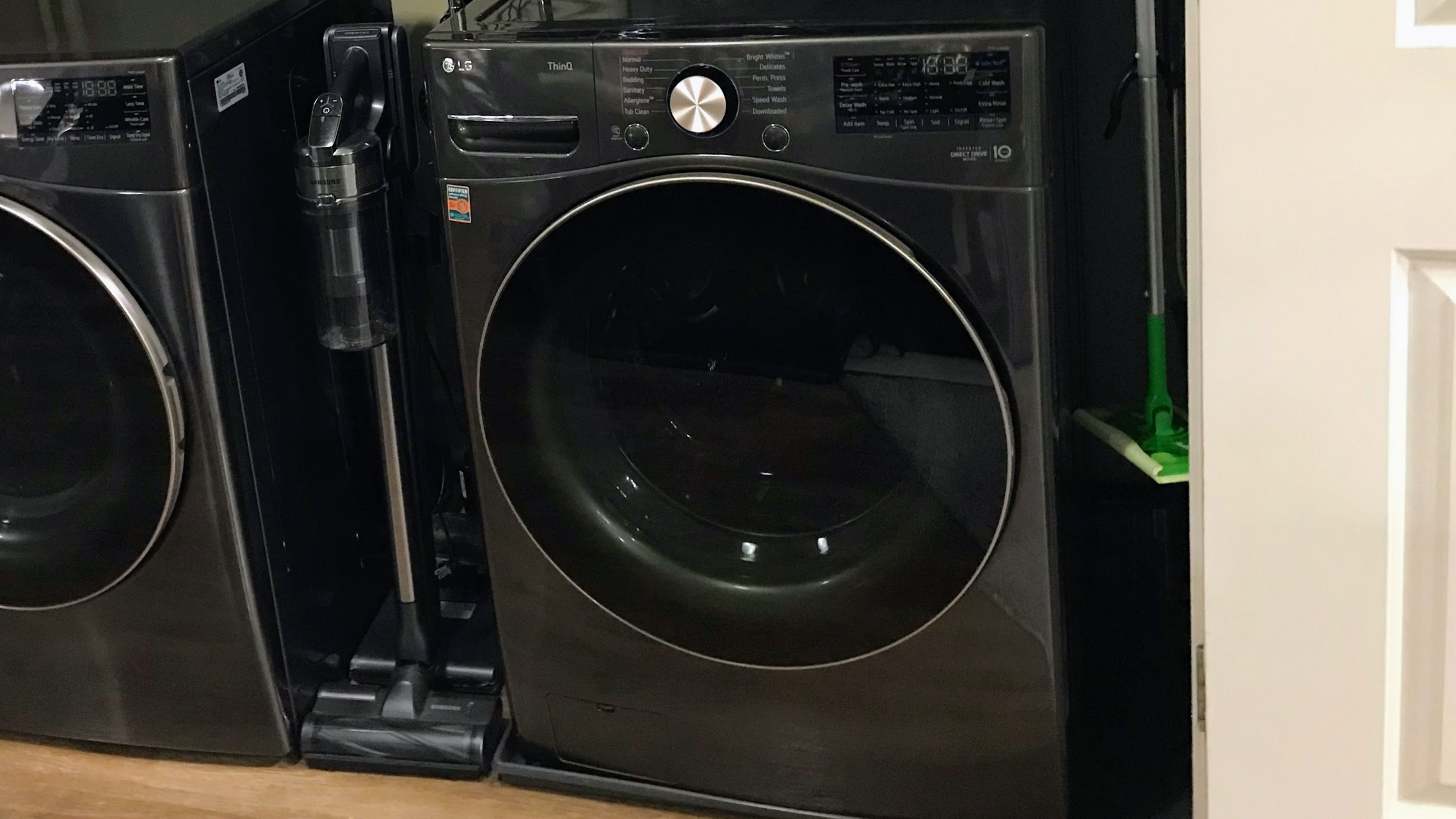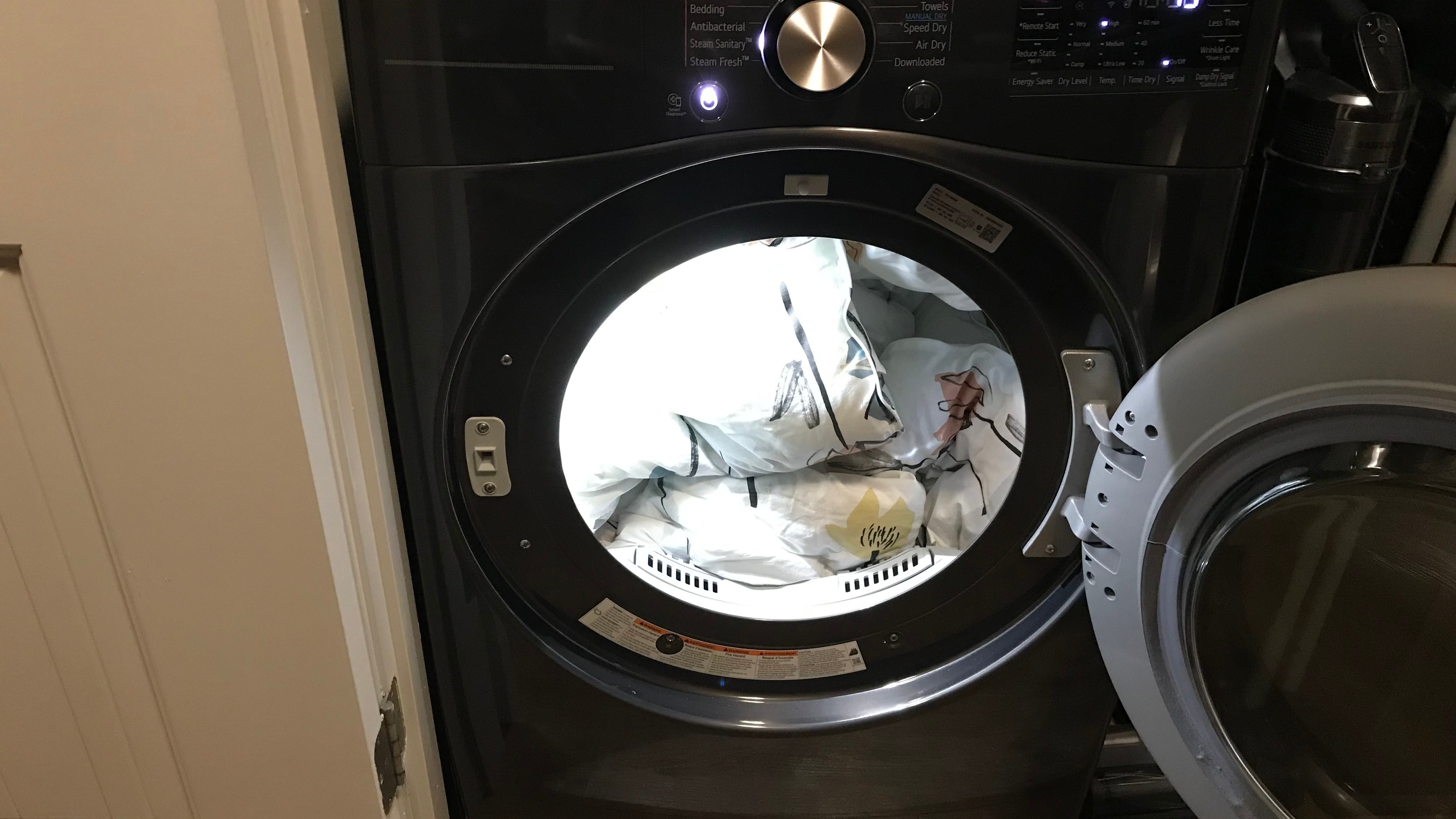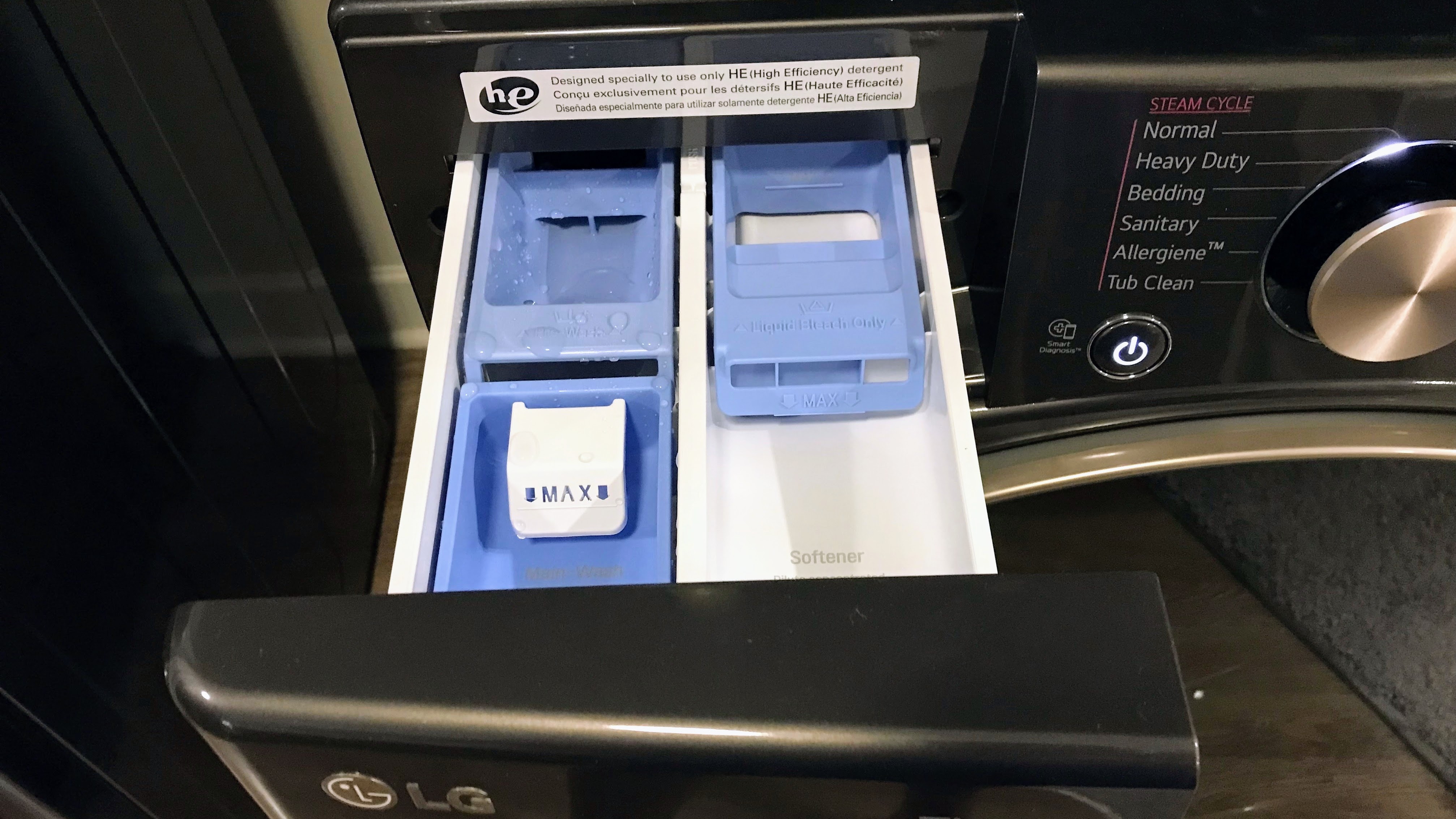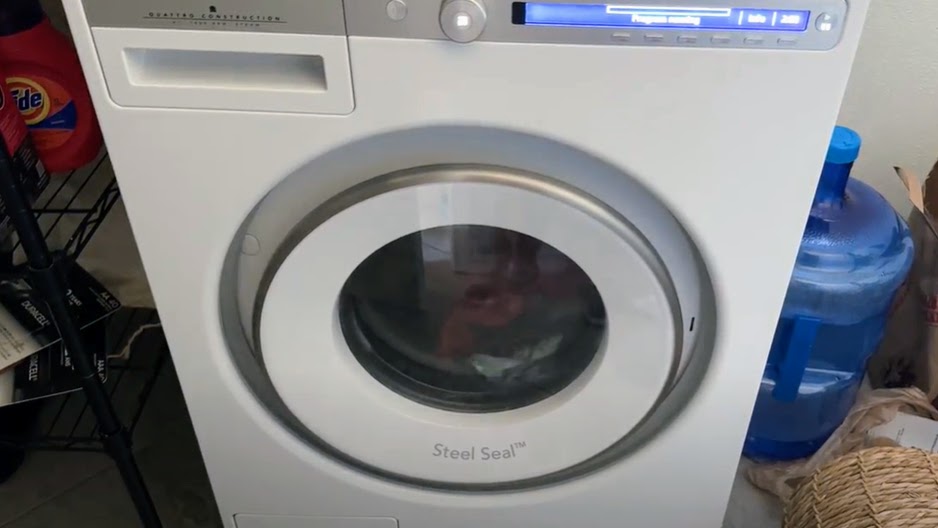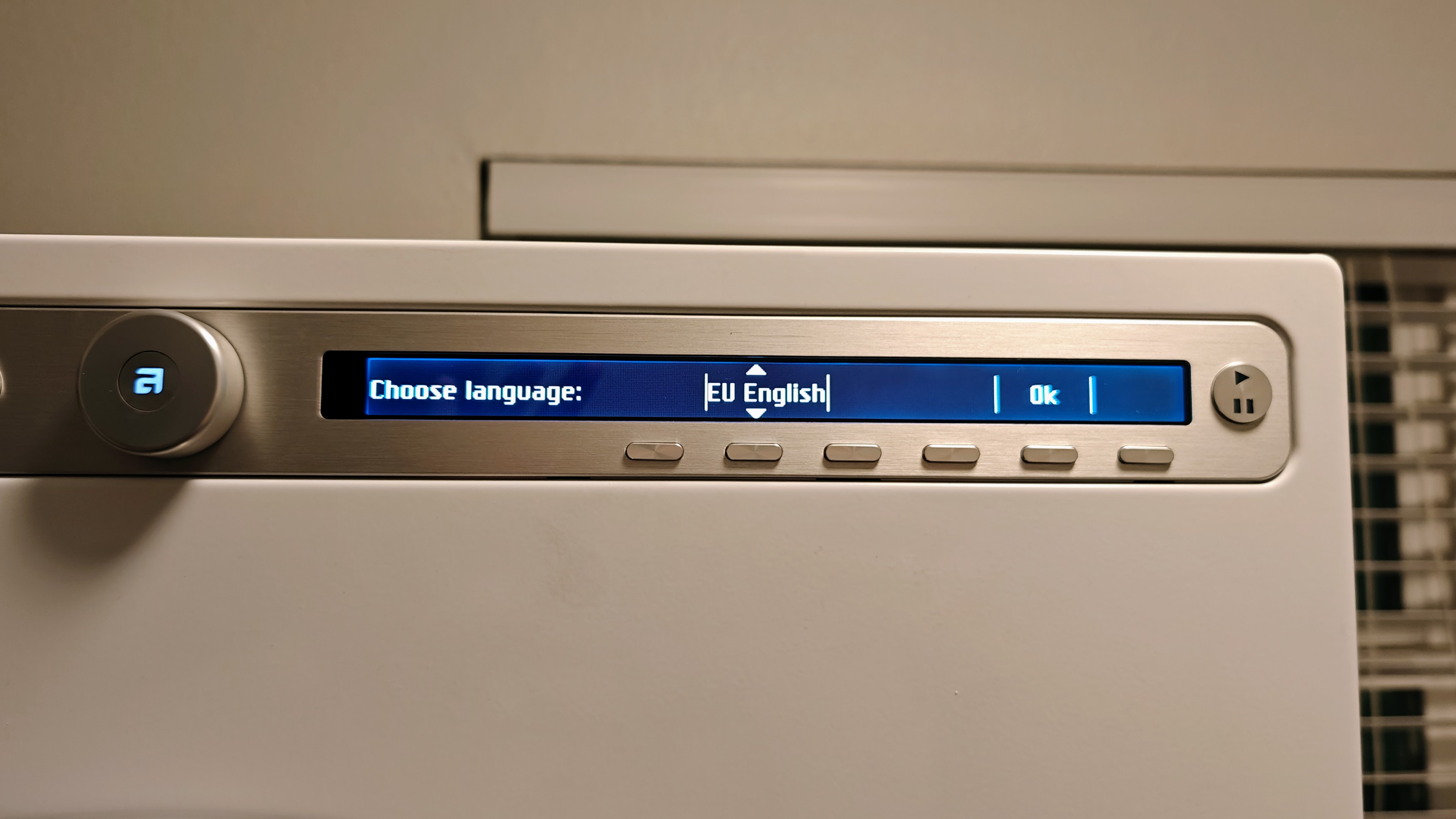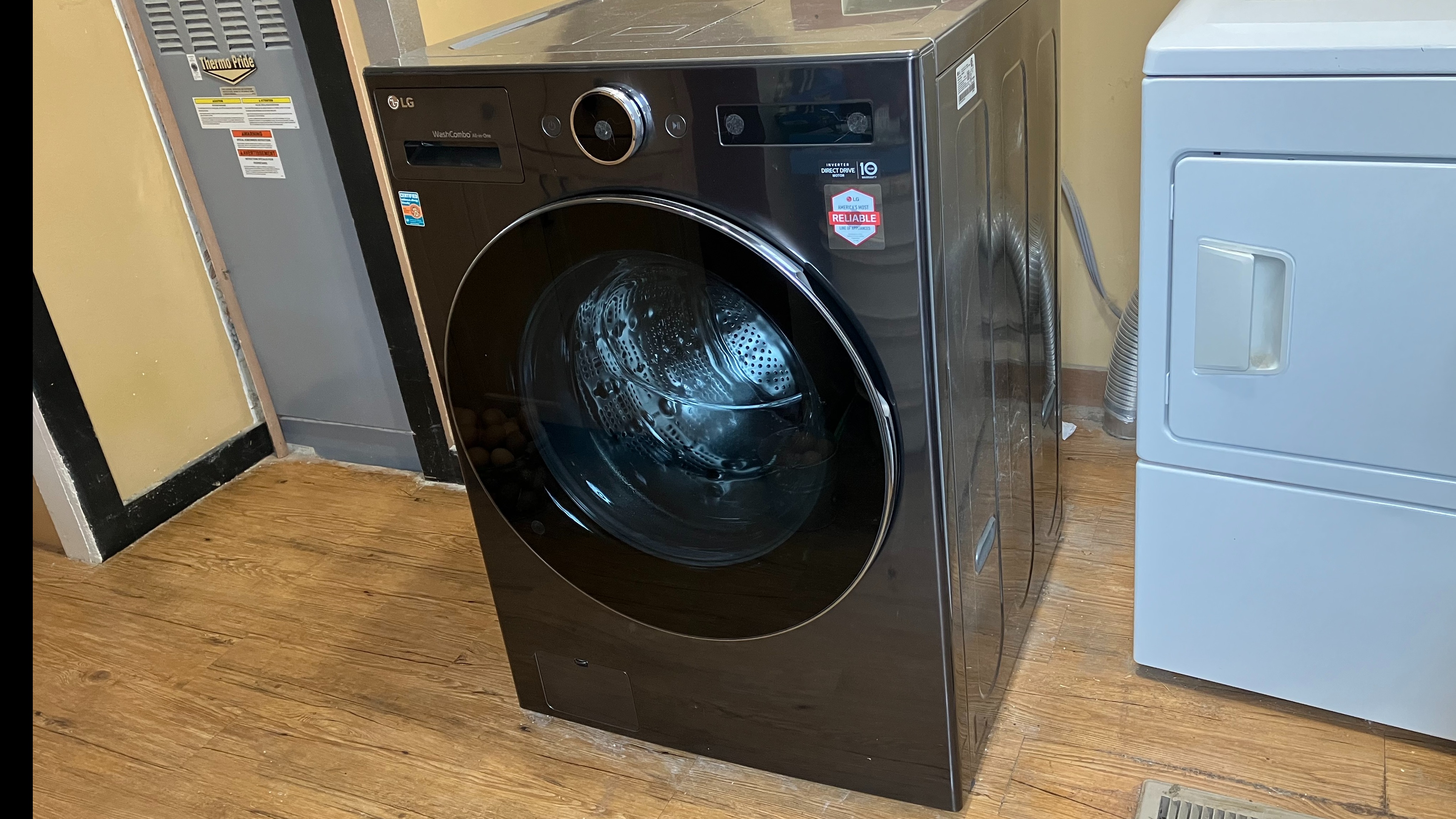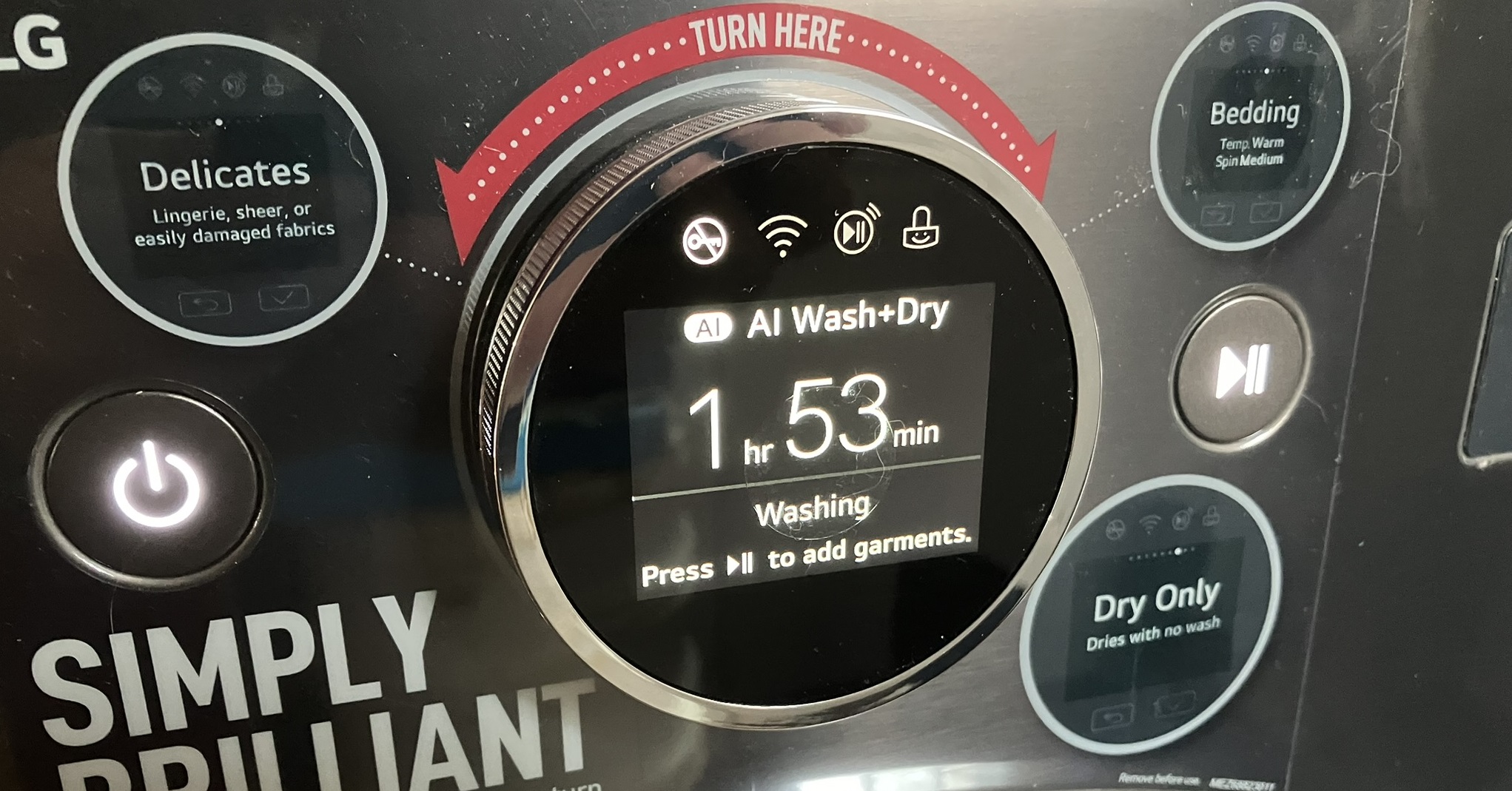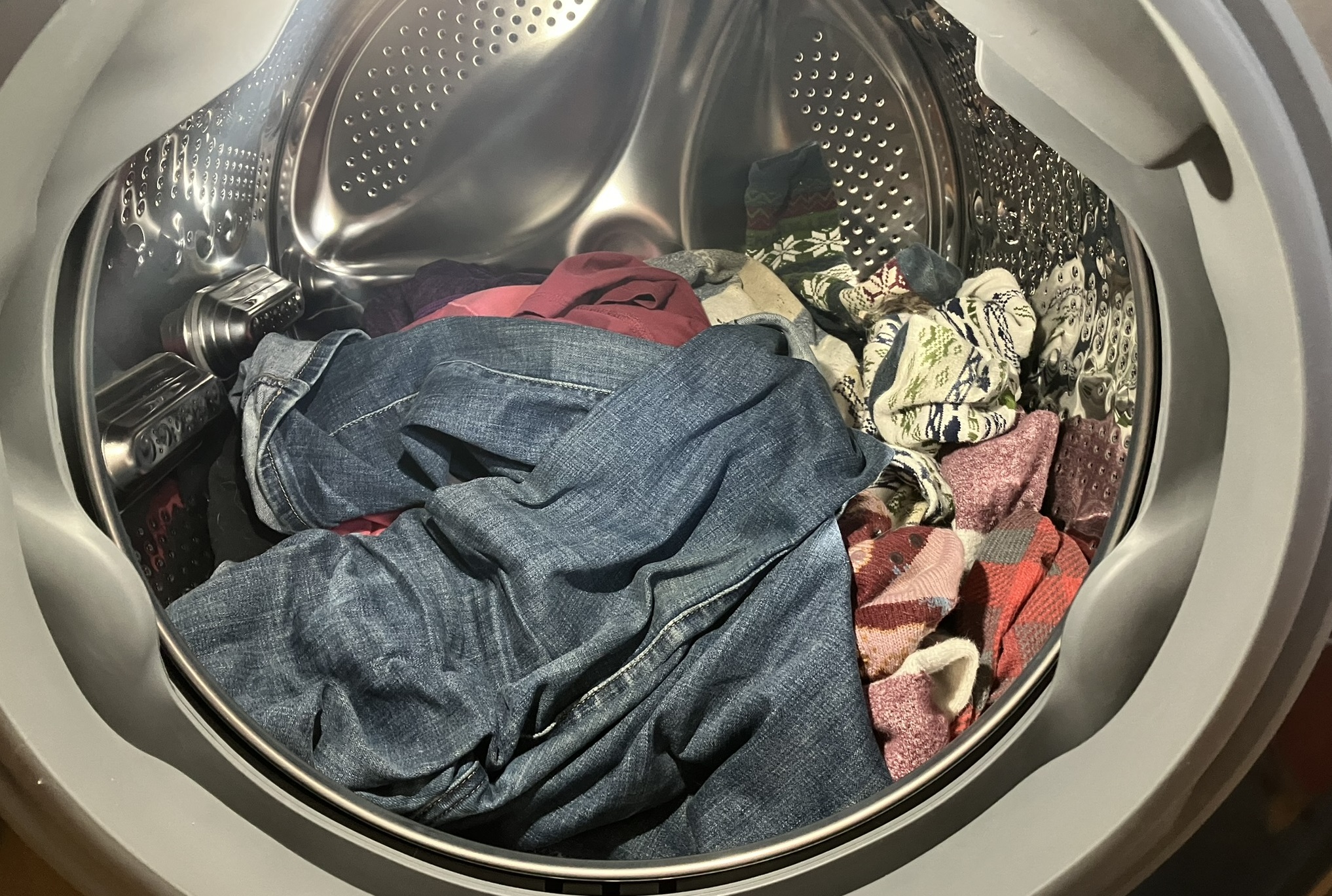The best front-load washers are an excellent option for saving energy and space. They can be stacked on top of a dryer, making them ideal for apartments or small spaces. Choosing the best washing machine with an Energy Star certification can lead to long-term savings on energy bills.
A washer with over five cubic feet capacity is a good choice for large families. Models with over eight cycles offer different ways to remove stains, dirt, and grime, useful for people who play sports, spend time outdoors, or cook frequently.
The price of front-load washers varies from $700 to $2000, depending on their capacity, features, and cycle types. The best models often have innovative features like AI-powered settings prediction or remote cycle scheduling. Steam settings are also gentle on stains.
Keep reading to see our top picks and head to our best top load washers guide for their counterparts.
The quick list
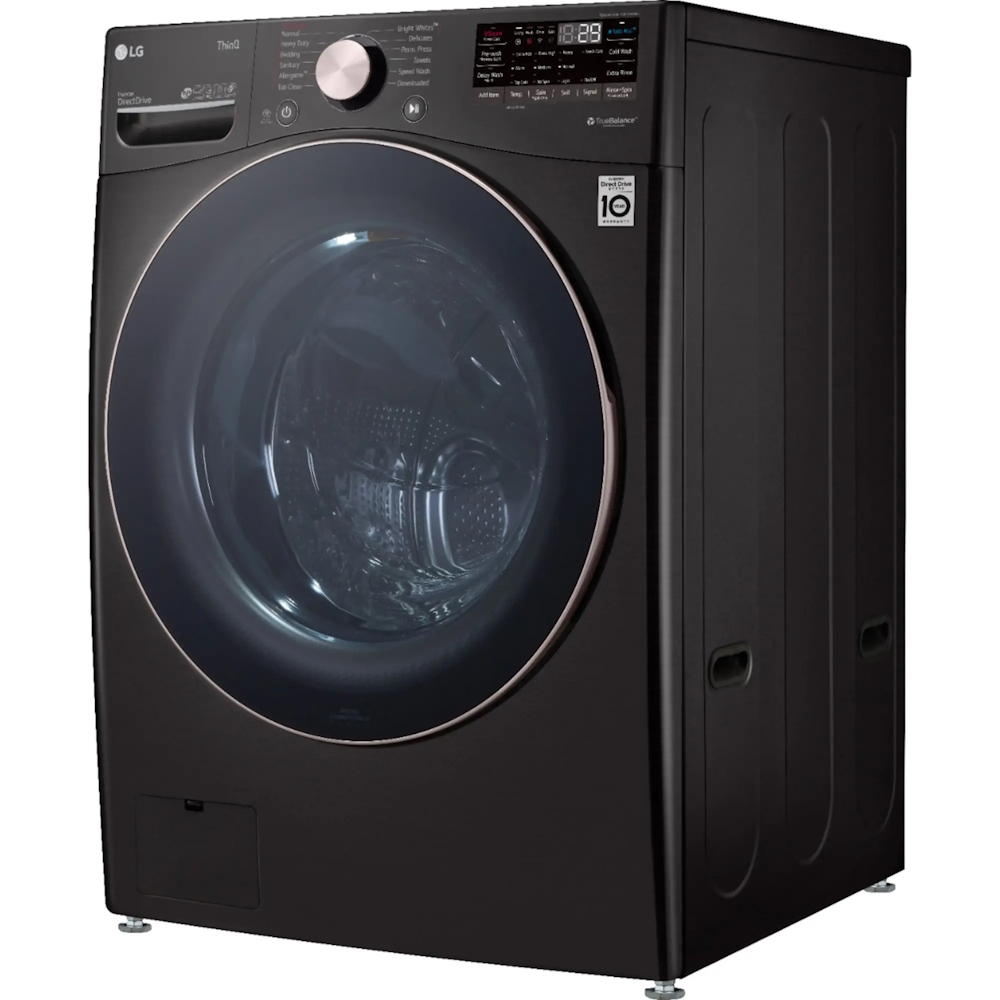
The best front-load washer overall
The LG 4.5 Cu. Ft. Smart Front Load Washer improved Terri's laundry experience with its sleek design, efficient cycles, and impressive spin performance. It's easy to maintain.
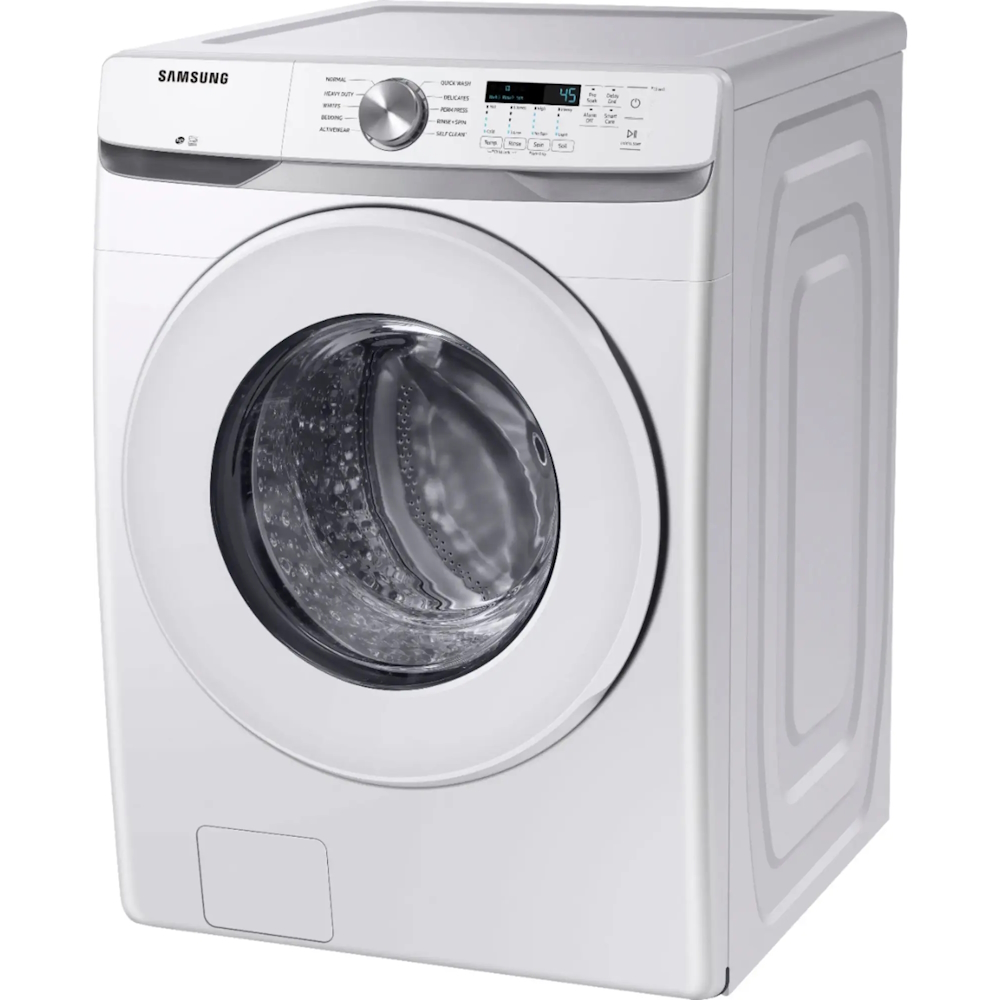
The best front-load washer on a budget
The Samsung 4.5 cu. ft. front-load washer offers efficient cleaning, quiet operation, a compact design, Smart Care, multiple settings, and a 20-year motor warranty.
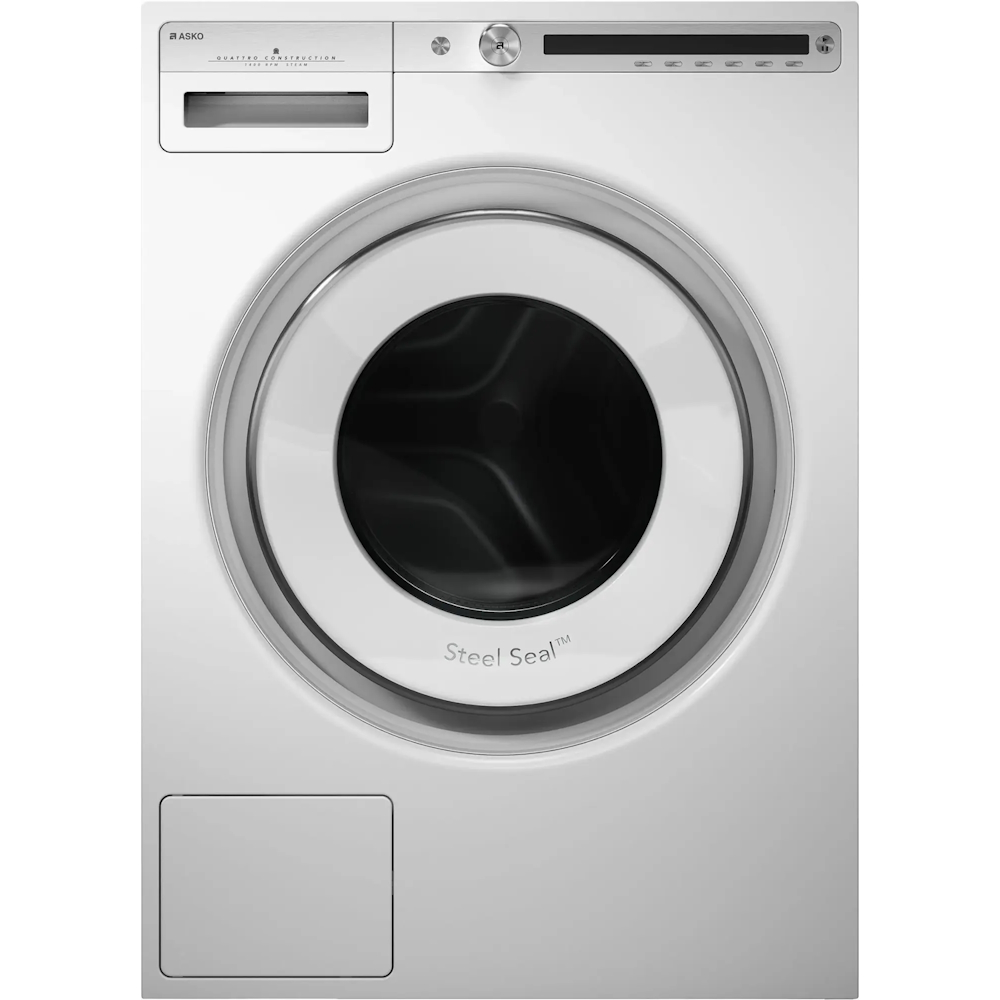
The best premium front-load washer
The ASKO Steel Seal washing machine offers 22 versatile wash settings, a compact design, easy controls, and efficient performance, making it ideal for family laundry.
Load the next products ↴
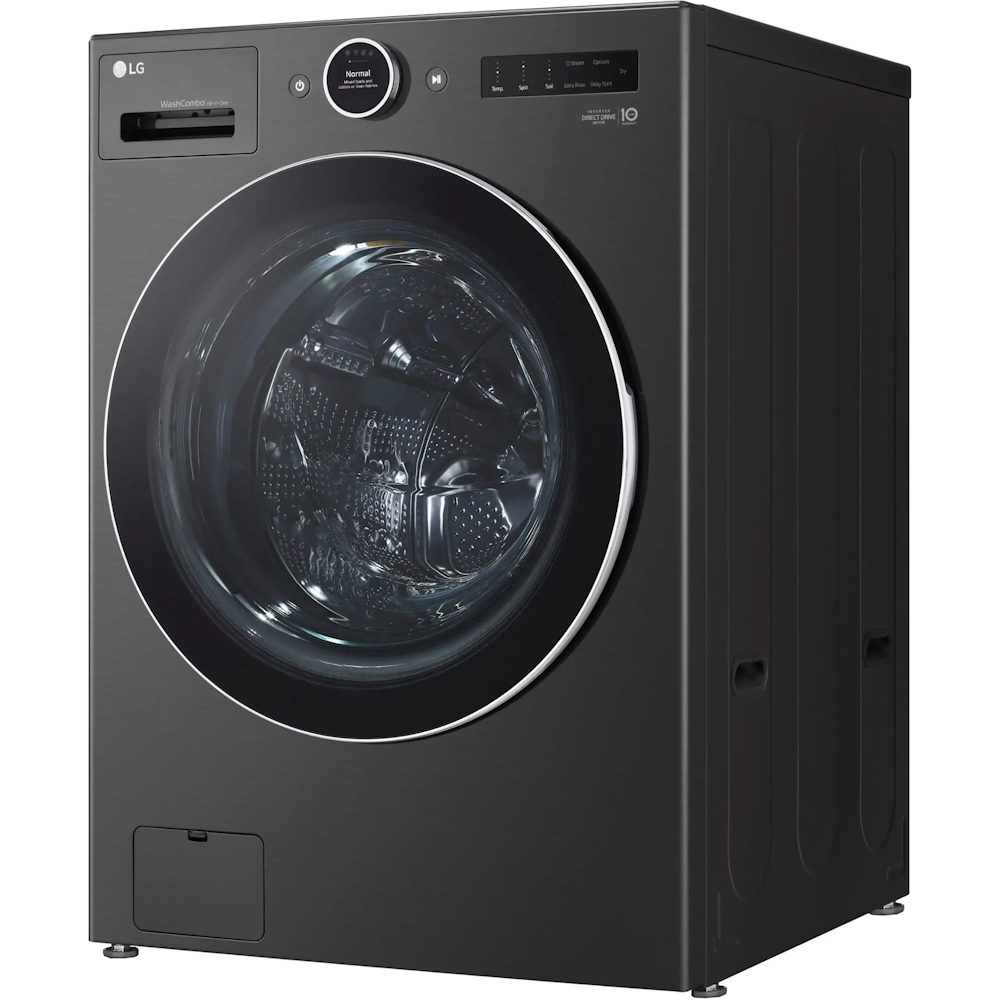
The best front-load washer-dryer combo
The LG 5.0 cu. ft. Mega Capacity All-in-One Washer/Dryer Combo is space-saving, efficient, and user-friendly. It features smart technology, a sleek design, and excellent cleaning performance.
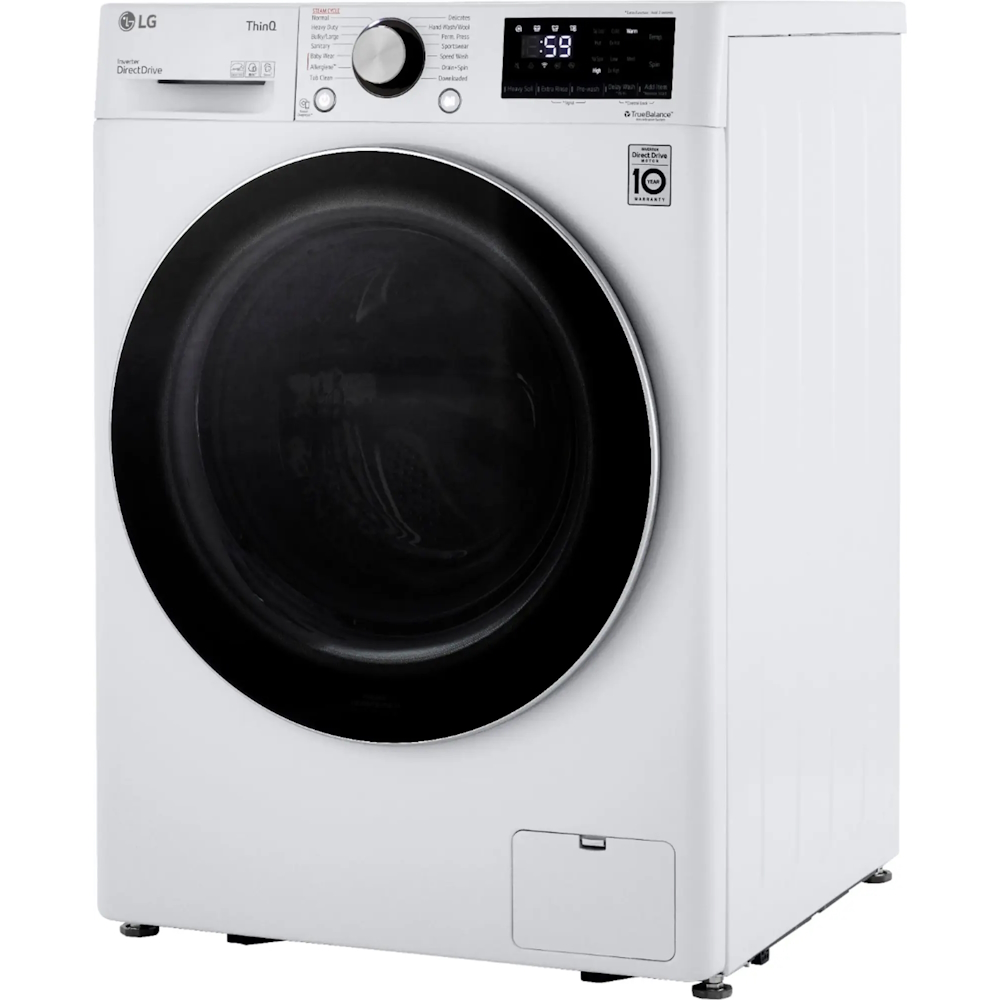
The best compact front-load washer
The LG 2.4 Cu. Ft. Stackable Smart Front-Load Washer features AI technology, an Allergy cycle, energy efficiency, and remote control compatibility with LG ThinQ.
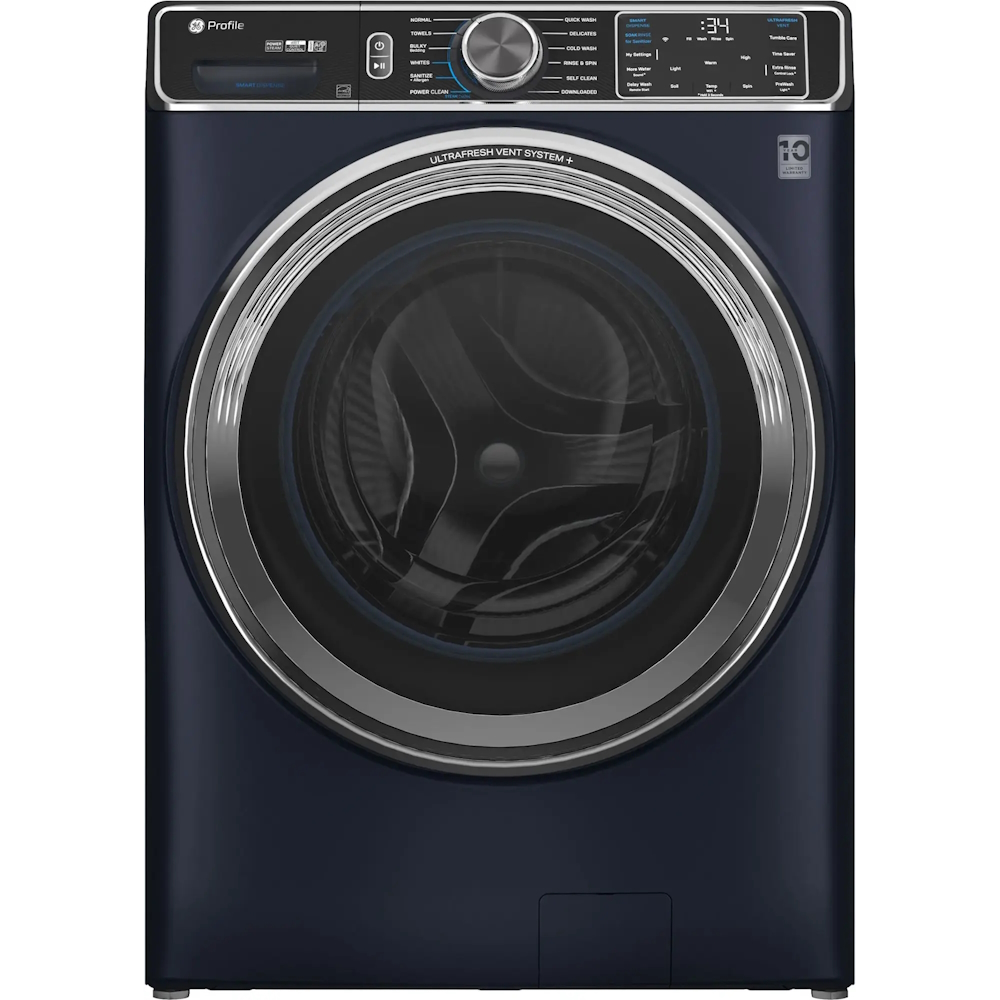
The best large-capacity front-load washer
The GE Profile 5.3 Cu. Ft. Front-load washer offers a large capacity, smart features, energy efficiency, and advanced cleaning technology for an easier laundry experience.
The best front load washers we recommend in 2025
Why you can trust Top Ten Reviews Our expert reviewers spend hours testing and comparing products and services so you can choose the best for you. Find out more about how we test.
The best front load washers we've tested
Our team has thoroughly reviewed the following products featured in this buyer's guide. We strive to provide comprehensive and unbiased rankings based on our hands-on testing and expert research. Our evaluations consider top-rated brands and essential features to assist you in making informed purchasing decisions at the best value.
The best front load washer overall
The LG WM4000HBA 4.5 Cu. Ft. Smart Front Load Washer impresses with its ample capacity and energy efficiency, making laundry tasks easier. With various wash programs and smart features, it delivers outstanding washing results while saving time, energy, and resources.
Washing Capacity: The LG WM4000HBA has a capacity of 4.5 cubic feet, which was enough for our reviewer, Terri's laundry needs. It could handle everything from small loads to bulky bedding without compromising performance, with even a comforter fitting well - albeit tightly. Knowing that she could wash many jeans or towels without overloading the machine reassured Terri, saving her time and energy by not having to do multiple loads each week.
Energy Efficiency: Terri loved the machine's energy efficiency. Its streamlined wash cycle saved her money while still ensuring a good wash. The appliance adjusts water levels based on load size, so it doesn't waste water. Since switching to the washer, she has noticed a significant decrease in energy consumption. Terri also highlights the impressive energy rating, which gives her peace of mind, knowing she's helping the environment while keeping her clothes clean.
Wash Programs: The LG WM4000HBA has many wash cycles, including steam, prewash, and Speed Wash for small loads that take just 15 minutes. The options are tailored to different fabrics and soil levels so that you can choose the right setting for each problem. Terri loved the ability to customize the temperature, spin speed, and soil settings. The results of tests with strains like grape jelly and coffee were superb, with each cycle living up to expectations.
Smart Features: The machine's smart features allow you to control it remotely, check power consumption, and receive notifications when a cycle is over with the LG ThinQ app. The digital display is easy to navigate, so Terri could start laundry while running errands. She also loved the fault diagnosis, which alerted her to potential issues before they became major problems.
Washing Efficiency: The LG WM4000HBA shines in washing efficiency. After testing, it was clear that the washer was great for tackling tough stains and maintaining fabric integrity. Terri's experiments with different materials and stains showed excellent results, and everything came out cleaner than expected. The powerful spin cycle gets rid of excess water, and it's also quick to dry.
Read more: LG WM4000HBA 4.5 Cu. Ft. Smart Front Load Washer review

"This LG WM4000HBA 4.5 Cu. Ft. Smart Front Load Washer is sleek and stylish, loaded with features, and performs well on various cycles. However, it takes a while to review all of the features."
| Attribute | Notes | Score |
|---|---|---|
| Setup | professional installation options, quick setup, and user-friendly controls | 8/10 |
| Design | aesthetics, functionality, and user-friendly features | 9/10 |
| Performance | excels in performance with its effective cleaning capabilities, versatile settings, and user-friendly features | 9/10 |
| Maintenance | straightforward, with regular tasks such as wiping down the door and seal, running a Tub Clean cycle, and cleaning the dispenser drawer | 8/10 |
| Value | competitive sale price; availability issues; set purchase option | 6/10 |
The best premium front load washer
The ASKO Steel Seal washer boasts impressive washing capacity and energy efficiency, making it ideal for busy households. With 22 versatile wash programs and straightforward controls, it effectively tackles various fabric types and stains while prioritizing eco-friendly practices—all without the complexities of smart technology.
Washing Capacity: The ASKO Steel Seal is compact but can wash a surprisingly large amount of clothes. Our reviewer, Jason, constantly washes clothes, towels, and sheets at home with two small kids and a dog. He could fit almost as much in as he did with his old Maytag top loader. During testing, he completed multiple loads, but it never felt excessive. Eight bath towels are no problem.
Energy Efficiency: The ASKO Steel Seal washer is also energy efficient. Its green mode saves water and energy—even if washing takes longer. Knowing that his washer was eco-friendly, especially when energy bills could unexpectedly go up, was reassuring for Jason. While the machine doesn't feature smart Wi-Fi connectivity to track consumption, it still simplifies the laundry routine without draining resources. The family saw a positive impact during testing.
Wash Programs: The washer has 22 wash programs, and Jason tested out a few of them. In addition to the Universal Wash, he tried Allergy and Shirts, which didn't disappoint. You can switch between programs easily with a selection of dials and buttons and customize settings like temperature and spin speed. Each cycle caters well to different laundry, so Jason was confident in tackling various fabric types and dirt.
Smart Features: Compared to Jason's previous washer, the ASKO Steel Seal sticks to the basics. It's not equipped with Wi-Fi or high-tech features, but he likes the simplicity, and the machine does recommend the right amount of detergent for his loads. The Child Lock is also an excellent addition, and the simplicity of turning knobs and pressure physical buttons is refreshingly straightforward in the digital age.
Washing Efficiency: Jason was genuinely impressed by the washer's efficiency, testing it with stains and finding it performed well across the board. Most of the stains came out during a regular cycle, and he didn't have to iron the shirts after using the steam cycle on a shirt program, reducing wrinkles.
Read more: Asko W4114CW 2.8 Cu.Ft. Front Load Washer review

"The ASKO Steal Seal W4114CW washing machine is a quiet, efficient, high-quality washer for the modern age. With more than 20 different wash settings, it’s more than equipped to handle any washing you need. However, it’s not the most spacious washer, so it might not be the best option for a big family. It’s also quite expensive, so you’ll have to decide if it’s worth the investment."
| Attribute | Notes | Score |
|---|---|---|
| Setup | straightforward and can be completed without professional assistance; instructions could be clearer in some areas; flexible installation options, such as side-by-side or stacked configurations | 7/10 |
| Design | aesthetic appeal, thoughtful control layout, innovative features, and versatility in wash programs | 9/10 |
| Performance | excellent washing performance, effectively handling various loads and stains; Universal Wash program performs well; steel seal design prevents dirt and odors | 8/10 |
| Maintenance | periodic tasks like running a Drum Cleaning cycle and cleaning the filter and detergent drawer; steel seal reduces the need for frequent cleaning compared to rubber seals | 9/10 |
| Value | steep price may deter budget-conscious consumers | 6/10 |
The best front load washer dryer combo
The LG washer-dryer combo's 5.0 cubic feet capacity is impressive, giving it the ability to handle large loads like queen-sized comforters. The machine boasts energy efficiency, 15 wash programs, smart features, and overall effective cleaning, making her laundry experience seamless and efficient.
Washing Capacity: Our reviewer, Paige, was pleasantly surprised by the LG WM6998HBA's washing capacity. The machine has an impressive 5.0 cubic feet capacity, so she can easily fit a queen-sized comforter inside without any issues. As she washed a lot of bedding and towels, Paige liked not worrying about exceeding the machine's limits. The lack of an agitator makes loading and unloading much more straightforward.
Energy Efficiency: The washer-dryer combo uses less water and electricity than traditional washers and dryers, meaning Paige didn't need to worry too much about utility bills. While using it, she noticed no significant increase in energy consumption.
Wash Programs: The machine has 15 preloaded wash programs, from quick washes to delicate settings, and each feature seems tailored for specific laundry needs. This flexibility allowed Paige to optimize her laundry routine based on her preferences since she could add or remove programs as needed. Her favorite was the Normal wash mode, which let her pull out clothes before drying.
Smart Features: Paige loved the two touchscreens, which are modern and highly responsive, making settings easy to navigate. The automatic detergent dispenser allowed her to put detergent in the reservoir and leave the machine to do the rest, and the AI Wash + Dry feature was invaluable on busy days.
Washing Efficiency: While the machine didn't wholly remove cat hair from sweatshirts, it cleaned them well overall, and Paige noticed that clothes came out fresh and clean after each cycle. Loads were free of dirt and odors using normal wash mode, and different fabrics were handled well.
Read more: LG WM6998HBA 5.0 Cu. Ft. HE Smart Mega Capacity All-in-One Electric Washer/Dryer

"Traditional washers and dryers take up much space, and switching loads over is inconvenient. The LG 5.0 cu. ft. Mega Capacity Smart Front Load All-in-One Ventless Washer/Dryer Combo streamlines the laundry process, saves space, and includes plenty of smart features for good measure. It's efficient, with the ability to automatically wash and dry laundry in two hours. Plus, when paired with LG’s smartphone app, you can monitor and even control the machine without being in the house. As a result, this washer-dryer combo is an appealing option for anyone with limited space, wants more precise control over their laundry, or just wants an easier option than a separate washer and dryer."
| Attribute | Notes | Score |
|---|---|---|
| Setup | installation instructions and included tools facilitate the process; initial delivery and moving challenges | 7/10 |
| Design | A sleek, modern design helps to save space, and the machine is about the size of a traditional front load washer | 8/10 |
| Performance | The machine performed well in most tests, including washing and drying in 2 hours, but struggled to dry bulky items like blankets and comforters | 8/10 |
| Maintenance | clear guidelines provided, and the proactive features that remind users of necessary tasks | 8/10 |
| Value | The price is about average for washer dryer combos and is justified with the many features | 9/10 |
More front load washers we recommend
Top Ten Reviews is on a mission to review everything we feature in our buyer's guides. Still, while we work hard to make this a reality—or where this isn't possible—some of our guides still feature rankings based on our team's considerable expertise and research.
While we haven't been able to test some of the units in this guide in person, we've instead honed in on top-rated brands and used our knowledge of the best features to help you make the right decision for your home, all for the best price.
The best front load washer on a budget
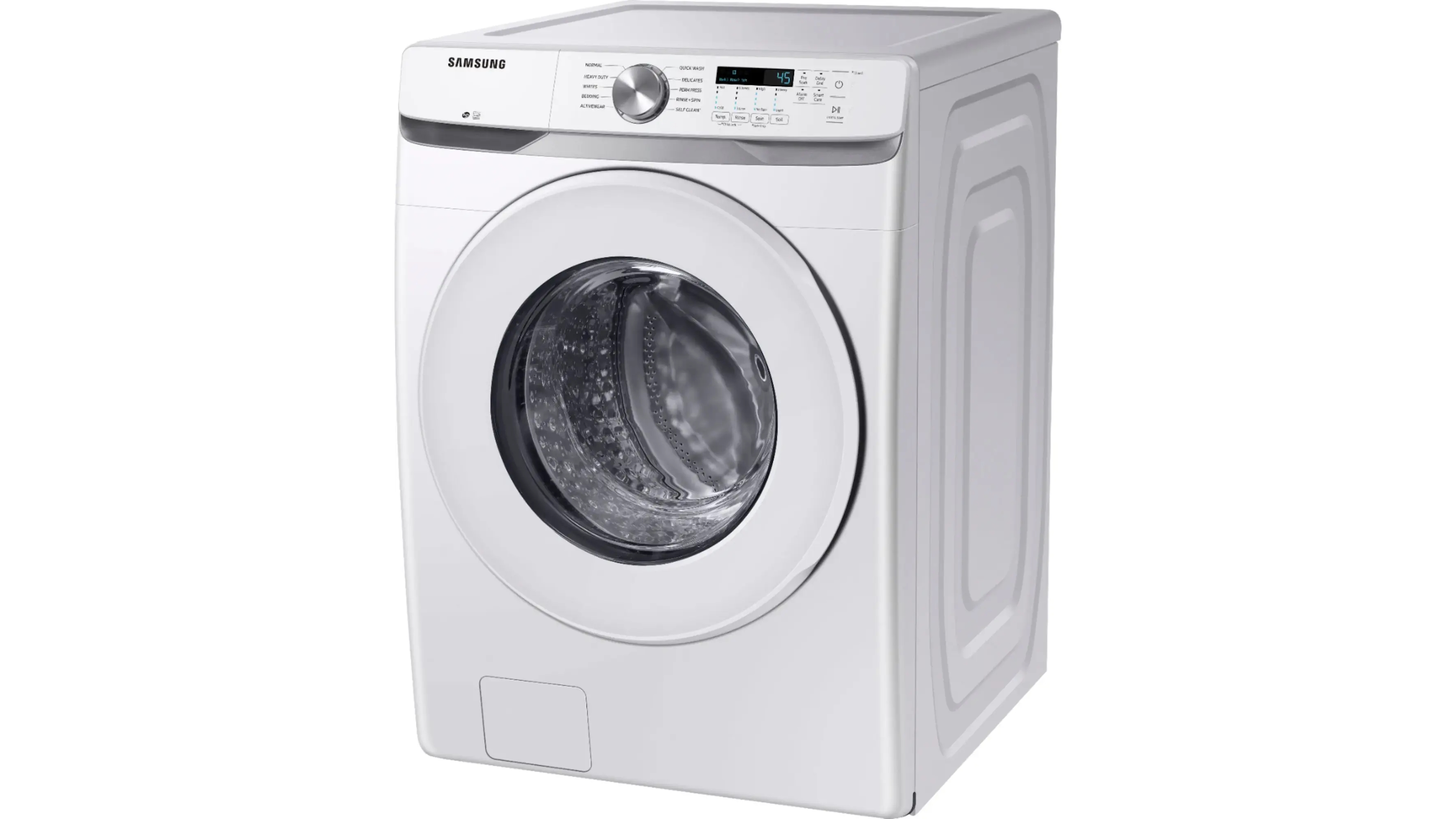
This Samsung front-load washer, with an impressive 4.5 cu. ft. capacity makes handling large loads easier, cutting laundry time without wasting the earth. Vibration Reduction Technology+ minimizes noise and disturbance while using this washer, and with Self Clean+, the machine eliminates 99% of bacteria in its drum, making it hygienic to wash.
Customers have praised the washer for its quiet operation and user-friendly interface, often praising its power to clean clothes efficiently. It has a big capacity, so you don't have to load as much. However, there are concerns about vibrations, warranties, installation, and durability in some feedback.
This washer is engineered for superior efficiency and convenience. Its stackable design benefits those with limited space, fitting seamlessly into smaller laundry rooms. Some reviews claim it exceeds expectations, even acting as a worthy successor to older models.
Samsung's 4.5 cu. ft. High-Efficiency Washer comes with Smart Care for easy troubleshooting via smartphone, a Swirl+ Drum Interior for better water extraction, and a closet-depth fit, so it fits anywhere. The machine also has ten preset washing cycles and six more options for fabric care.
This unit is the ultimate laundry solution, featuring five temperature settings and matching dryer options. Its digital inverter motor is backed by a 20-year warranty, giving you peace of mind.
The best compact front load washer
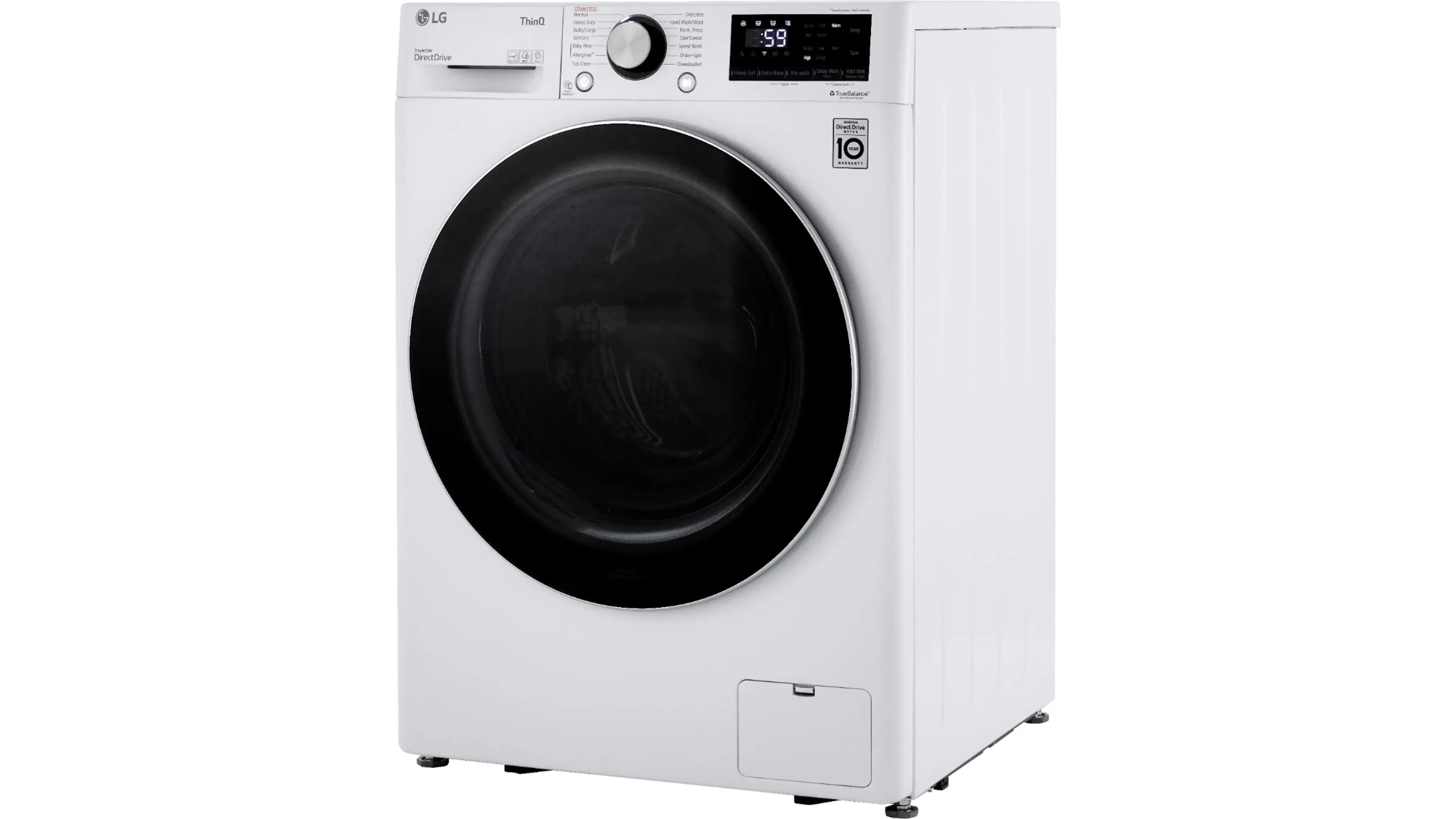
The LG 2.4 Cu. Ft. Stackable Smart Front-Load Washer's impressive features and stylish design stand out. With just 24 inches of width, this washer fits into tight spots like closets and laundry areas. With tempered glass doors and chrome accents, it's a stylish addition to any home.
The washer is equipped with built-in intelligence, utilizing advanced AI technology to detect fabric types and load sizes. It picks the right wash motion and temperature so your clothes get the best clean. A standout feature is the Allergy cycle, which eliminates more than 95% of allergens in your laundry using steam.
A compatible dryer can communicate with the washer to choose the best drying cycle, simplifying your laundry process. You can control your LG ThinQ washer from anywhere, get notifications when your laundry is done, and use voice commands to operate it with Google Assistant and Amazon Alexa with the LG ThinQ app.
Not only is this washer efficient in terms of performance, but it's also Energy Star certified, so it uses a lot less water and energy. With a Direct Drive Motor, it's quiet and vibration-free, and the stainless steel tub keeps things going.
The best large capacity front load washer
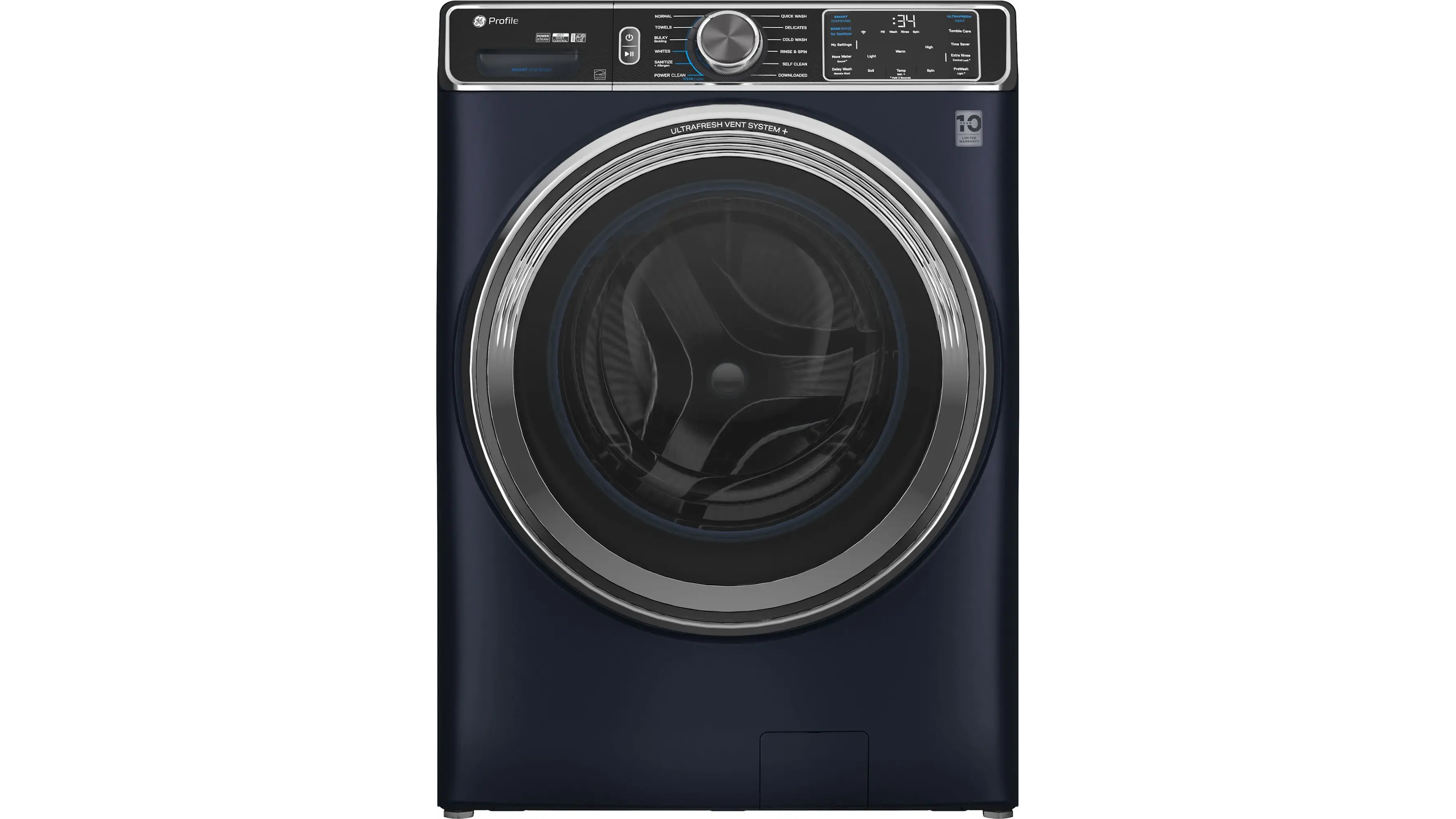
The GE Profile 5.3 Cu. Ft. High-Efficiency Stackable Smart Front Load Washer is one of the best options for modern households when it comes to large-capacity front-load washers.
One of the standout features is the UltraFresh Vent System+ with OdorBlock, a unique system that detects and removes excess moisture, keeping your washer clean and fresh between uses. This washer comes with Microban Antimicrobial Technology, which protects critical components.
With SmartDispense Technology, you can keep up to 32 loads of detergent on hand. This feature simplifies the laundry process and ensures that the right amount of detergent is dispensed based on the load size and fabric type, improving cleaning results.
With its steam function, the GE Profile washer penetrates deep into fabric fibers, removing stains and sanitizing clothes. With Dynamic Balancing Technology (dBT), laundry runs quietly by sensing and rebalancing uneven loads during the spin cycle.
This washer is also ENERGY STAR certified and meets CEE Tier 2 specifications, so you can save on utility costs without sacrificing performance.
The washer's big capacity, efficient performance, and smart features get great reviews. If you're looking for a reliable, feature-rich front load washer that makes laundry day easier, the GE Profile 5.3 Cu. Ft. washer is a great choice.
How to choose the best front load washer for you
Choosing the best front-load washer involves several key considerations. Here's a guide to help you make an informed decision:
Capacity: There are many options for front-load washers, typically from 4.2 to 5.8 cubic feet. Your household size and laundry frequency should be taken into consideration. Larger capacity models are great for families because they let you wash more clothes in a single load, while smaller models are good for singles or couples.
Energy Efficiency: Washers with the ENERGY STAR label use less water and electricity, saving you money on utility bills and helping the environment.
Spin Speed: When you wash your clothes, the spin speed, measured in revolutions per minute (RPM), determines how much moisture remains after washing. Higher RPMs (around 1200-1400) mean drier clothes, which means less energy and drying time.
Cycle Options: Ensure the machine has specialized wash cycles for delicates, heavy-duty items, or quick washes. Additional features like steam cleaning and sanitizing can also improve cleaning.
Smart Features: Modern washers can be controlled with smartphone apps or voice commands. Features like notifications and remote monitoring can make laundry easier.
Brand Reputation and Warranty: A good warranty means the manufacturer believes in the product. Look for models with a one-year warranty.

Glenn Lewis was named president of Mr. Appliance, North America’s leading appliance repair franchise providing customers with full-service residential and light commercial appliance repair, in May 2024. He is responsible for the overall leadership and growth of Mr. Appliance throughout the US and Canada. Before Neighborly, Glenn served as Executive Vice President at The Décor Group in Lubbock, Texas.
Glenn Lewis, the president of Mr. Appliance, a Neighborly Company, spoke to us about the benefits of front-load washers:
Lewis adds, "Open from the front, and the drum is horizontal. These machines tumble clothes using gravity, which is more gentle on fabrics and uses less water and detergent. They’re also more energy-efficient and typically provide better cleaning. The downside is that they can take longer to finish a wash cycle, but they come with various advanced features and settings to cater to different fabric types.
"A wash-dry combo machine is an all-in-one unit that washes and dries clothes. It’s perfect for small spaces where you can't fit a washer and a dryer. However, the drying process in these machines, often ventless, can take longer than traditional dryers. They're convenient but might not dry large loads as efficiently as separate units."

Matthew Glynn is Hisense's Product Marketing Manager for white goods and appliances. Matthew has worked in a product development/management role for over 10 years and has previously worked across marketing and R&D functions with FMCG and CE. Matt focuses on the consumer arm of products at Hisense, focusing on white goods, with a passion for the products and ensuring consumers have the best experience.
‘“The better the energy rating on a washing machine, the more money you’ll save in the long run,” says Matthew Glynn, Product Marketing Manager for Hisense UK, on how to save money on your laundry.
“You can also use specific programs on the machine, such as Eco Wash, as this best combines low temperature and energy consumption. If your machine has a large capacity, you’ll also save on energy by doing fewer loads of washing. I’d recommend this, particularly for larger households.”
Front load washer FAQs
How do front load washers work?
In contrast to top-load washers, front-loaders have a door on the front, allowing easy access to the drum. The drum is mounted horizontally, allowing gravity to assist the washing process. This design allows larger loads and better cleaning.
High-efficiency (HE) detergents make fewer suds, which ensures optimal cleaning while preventing overflow. When you start the wash cycle, the washer fills with water and detergent. A front load washer uses tumbling rather than an agitator. The drum rotates, lifting and dropping clothes, mimicking the motion of hand washing. This gentle tumbling helps remove dirt and stains.
After the wash cycle, the washer enters a spin cycle. The drum spins at high speeds to remove excess water, which reduces drying time. Modern front-load washers have sensors that detect load size and soil level, adjusting water levels and cycle duration to maximize efficiency.
After washing and spinning, water is drained through a pump. Front load washers also have drain filters to catch lint and debris.
Why should I switch to a front load washer?
Though they are often criticized for their smaller load size and longer cycles, the merit of the best front-load washers is not too difficult to see. They tend to perform better in cleaning tests thanks to their thorough washing movements, and they’re also more readily available and versatile in shopping choices than their competitors, the best top load washers.
Improved energy efficiency
Front-load washing machines use less water and power, which is good news for the environment and your bank balance. Unlike top-loaders, front-loaders don’t need to fully submerge your clothes to wash them; instead, they use gravity to tumble laundry through the water.
Consumer Reports say they use just over one-third of the water top-loaders. That's to say nothing of the power savings, as front-load washers use, on average, 60% less energy than top-load washers. There are other savings to make with a front-load washer, as they cause less wear and tear on clothes and require less maintenance.
They're stackable
Unlike traditional top-loading washers, front-load washing machines can be stacked, so you can place your dryer above or below the washer and save space in your laundry room. However, this means you won’t be able to use an optional pedestal drawer (see below), creating the need to bend down when loading and unloading. Perhaps not so great for the elderly or those with reduced mobility. Stacking remains a handy option, though, and will largely depend on your available space.
Pedestal drawer storage options
As mentioned above, most front-load washers have an optional pedestal drawer. This drawer makes the washers easier to load and adds a lot of storage space to the laundry room. This is especially useful if the laundry room is small and cramped, as many tend to be. The pedestal drawers must be purchased separately, which is an added expense, but the storage and ergonomic benefits may very well outweigh the extra cost.
Vibration control
Front-load washers are quieter than their top-loading counterparts because they use less water and don’t use impellers to clean clothes. The best front loaders are also equipped with vibration control to help the appliance stay balanced even when a heavy load of laundry is spinning dry. This combined means that the appliance is quiet enough to operate on a second floor without disturbing that floor or the one below while it is running, a massive plus for apartment dwellers and their neighbors.
Advanced features
Although top-load washers now have more advanced features, upgrading to a front-loader washer from your current top-load washer will not only bring you up to date and help you be more energy efficient but will also allow you to take advantage of the advanced features that are now standard on these significant appliances. These include specialty wash cycles, energy-saving options, a vibration control system, and more.
The specialty wash cycles often include allergen, sanitize, and clean washer cycles, which are all incredibly helpful. Energy-saving options often include cold wash cycles and options that use less energy but still provide excellent wash performance.
How much do front load washers cost?
Depending on its features, brand, and capacity, a front-load washer can cost between $800 and $2,300.
For smaller households or those with lighter laundry needs, entry-level front-load washers start around $800 to $1,000. Mid-range washers range from $1,000 to $1,500 and offer more advanced features like steam cleaning, larger capacities, and enhanced energy efficiency. They usually have smart technology that lets you control them from your smartphone.
High-end front-load washers usually cost between $1,500 and $2,300. These models have the latest technology, bigger drums, and extra features like advanced wash cycles, noise reduction, and energy efficiency. They're good for larger families or people who do laundry a lot.
The initial investment in a front-load washer can be more than that of a top-load washer, but they're usually more energy-efficient in the long run. Compared to top loaders, front load washers use about one-third less water, saving you $30 in electricity each year.
If you're stacking your washer and dryer, don't forget to factor in additional costs like delivery, installation, pedestals, or stacking kits.
How long do front load washers last?
On average, a front-load washer lasts about 11 to 14 years. This is based on regular use, usually around seven loads a week or one load a day.
A front-load washer's longevity can be affected by various factors. Usage frequency plays a big role; machines that are used frequently tend to wear out faster. Also, the quality of the washer can influence its life. A higher-end model has better components and technology to last longer.
A front-load washer's life depends on maintenance, too. By keeping it clean, checking for leaks, and ensuring proper drainage, you can prevent many common problems that can lead to premature failure. If you follow the manufacturer's maintenance tips, you can make the washer last a lot longer.
When is the best time to buy a front load washer?
Several factors come into play when considering the best time to get a front-load washer deal, which can help you get the best price.
The best time to buy a front-load washer is during big sales. Retailers usually offer huge discounts on large appliances like washers on holidays like Memorial Day, Labor Day, and Black Friday.
“Ahead of Black Friday, we’d suggest doing some initial research on models and look into what key features you’d like to have on your washing machine, for example, a quick wash feature, an eco-mode, or larger capacity,” says Glynn, Product Marketing Manager for Hisense UK.
“When it comes to purchasing on Black Friday, stick to the budget you’ve set out, and by using your research, you’ll find the best model you can for the price you want to spend.”
Another great time to buy is when manufacturers release new models, usually in the spring or fall. When new models come out, retailers often discount older models to get rid of them. It's a great opportunity to get a high-quality washer for a good price, even if it's not the latest one.
Off-peak seasons, like late winter or early summer, tend to have lower washer demand, so you can often get better deals.
How we test the best front load washers
We test front-load washers on several key areas: setup, design, performance, and maintenance.
During setup, we ensure that all the parts are included, such as the washer unit, hoses, user manual, etc. The washer is then placed on a level, stable surface so that it is easy to access water, drainage, and electrical outlets. We assemble it according to the manufacturer's instructions, making sure the hoses are securely attached. The machine's level is checked with a level tool, and its legs are adjusted to minimize vibration.
In the design evaluation, we evaluate the control interface for intuitiveness and clarity, making sure buttons and settings are clearly labeled. We also check the ease of loading and unloading laundry, so make sure the door opens wide enough for convenience. You shouldn't have any trouble selecting wash cycles, including temperature and spin speed. Durability is determined by the materials used in the washer's construction, especially the drum and housing.
We run a full cycle on a bunch of dirty fabrics and assess their cleanliness afterward. The spin cycle is tested by weighing wet laundry before and after to measure water removal efficiency. We feel for detergent residue after washing and can use pH test strips to confirm rinsing effectiveness.
Meet the team

Jason is a freelance tech journalist and product reviewer who has reviewed tech gadgets and household products for over 10 years. He is not a fan of doing laundry and is always looking for ways to simplify the task. He and his family tested the ASKO Steel Seal W4114CW for about six weeks in their home with their two young kids and German Shepherd doggie.

Terri is a freelance writer living in Birmingham, AL. She has tested hundreds of products, including kitchen appliances, vacuums, bedding, furniture, luggage, and tech gear. Terri has bylines at Architectural Digest, Forbes, Popular Science, CNN Underscored, NBC News Select, The Daily Beast, USA Today, US News & World Report, Tech Radar, Homes & Gardens, and Tom's Guide. Follow her adventures @Territoryone. Terri tested the LG WM4000HBA 4.5 Cu. Ft. Smart Front Load Washer for several months, evaluating design, performance, user-friendliness, and maintenance. She was allowed to keep the set for ongoing use.

Paige Cerulli is a freelance writer and copywriter specializing in equestrianism. Her work spans product reviews, home renovation, and health articles, featured in outlets like Family Handyman and Business Insider. Based in Western Massachusetts, she lives with various pets and extensively tested the LG Mega Capacity Washer/Dryer combo.
